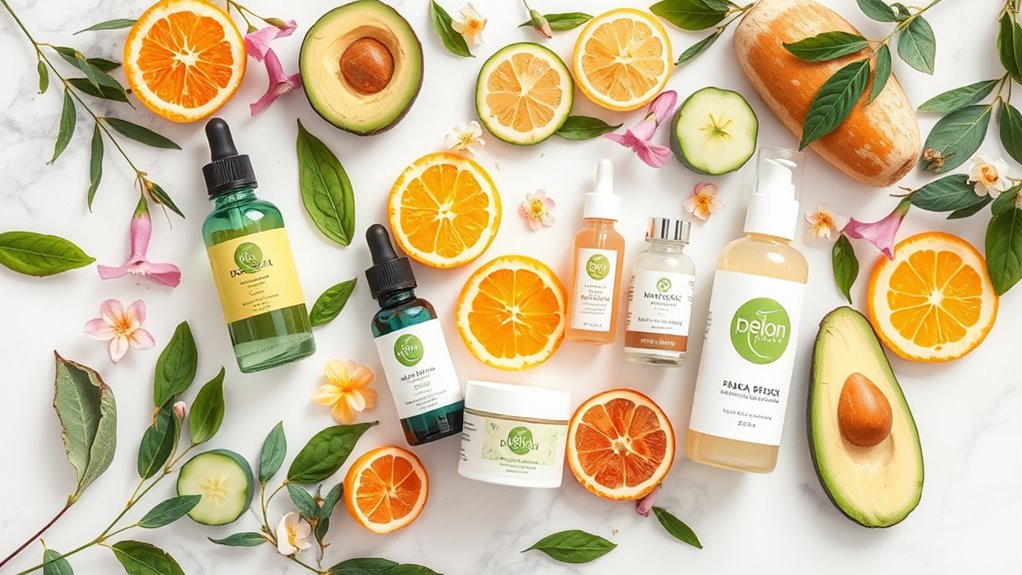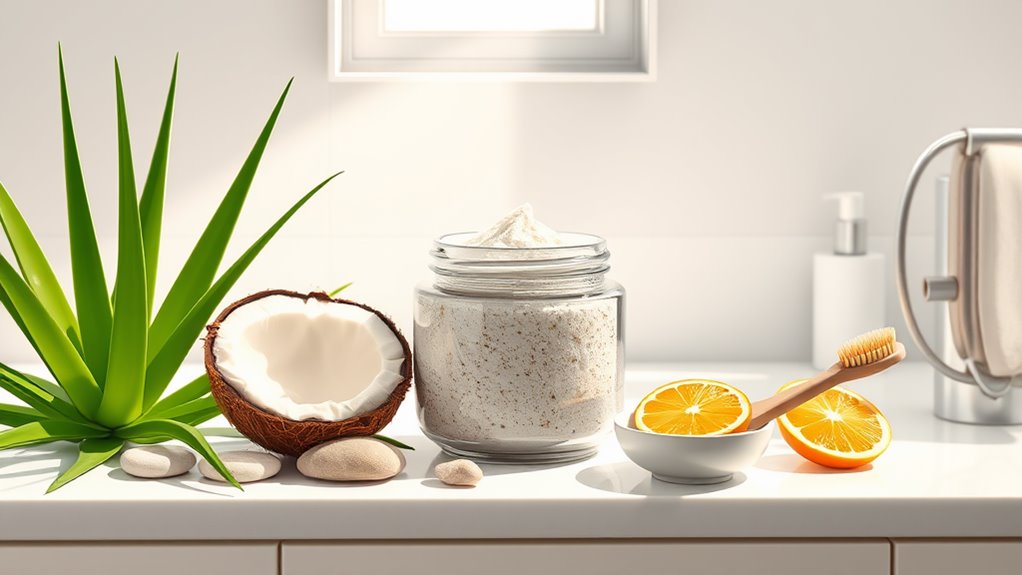How Exfoliation Can Make Your Skin Glow Instantly
Exfoliation can be a game-changer for your skin, offering an instant boost to your natural glow. By removing dead skin cells, it reveals a fresher, more vibrant layer underneath. This simple process can transform dullness into radiance, enhancing your overall complexion. But how do you know which method is best for you? Understanding the different types and techniques is essential for achieving that luminous look. Let’s explore what you need to know.
Key Takeaways
- Exfoliation removes dead skin cells, instantly revealing a brighter, fresher layer underneath for a glowing complexion.
- Physical exfoliants provide immediate results by sloughing off surface debris, enhancing skin’s texture and appearance.
- Chemical exfoliants penetrate deeper, addressing issues like acne and hyperpigmentation, leading to a more even skin tone.
- Regular exfoliation boosts cell turnover, promoting a radiant look by encouraging the growth of new skin cells.
- Choosing the right exfoliant for your skin type ensures effective results without irritation, maximizing your glow.
Understanding Exfoliation: What It Is and Why It Matters
When you think about achieving glowing skin, understanding exfoliation is essential. It’s the process of removing dead skin cells, revealing a fresh layer underneath. This not only enhances your skin’s appearance but also promotes cell turnover, leaving you with that coveted radiance. Incorporating scientifically-proven methods for exfoliation can significantly improve your skin’s texture and tone.
To master exfoliation, you’ll want to incorporate effective exfoliation hacks into your routine. For instance, try using a gentle scrub with natural ingredients or a soft washcloth to avoid irritation. You can also experiment with DIY masks that combine exfoliating agents like honey and sugar.
Types of Exfoliation: Physical vs. Chemical
Exfoliation comes in two main forms: physical and chemical, each with its unique benefits.
Physical exfoliation involves scrubs, brushes, or tools that manually slough off dead skin cells. This method provides immediate results, revealing a smoother texture and brighter appearance. However, be cautious not to overdo it, as aggressive scrubbing can irritate your skin.
On the other hand, chemical exfoliation uses acids or enzymes to dissolve dead skin cells at a deeper level. This method can penetrate pores, helping with issues like acne and hyperpigmentation. Research shows that better lifestyle choices significantly contribute to maintaining youthful skin.
While results may take longer to appear, the effects often lead to a more refined and even skin tone over time. Understanding the differences empowers you to choose wisely and achieve radiant skin.
Choosing the Right Exfoliator for Your Skin Type
Finding the right exfoliator for your skin type can make all the difference in achieving that coveted glow.
If you have oily skin, look for salicylic acid in chemical exfoliators to help unclog pores.
For dry or sensitive skin, opt for gentle formulations with lactic acid or mild physical scrubs.
Combination skin benefits from a balanced approach; try alternating between chemical and physical exfoliators.
If your skin is mature, choose products with antioxidants to combat signs of aging.
Always patch-test new products to avoid irritation.
Remember, your skin’s needs can vary with the seasons, so stay adaptable in your exfoliation routine.
Ultimately, mastering this selection process is key to revealing your skin’s natural radiance.
Step-by-Step Guide to Effective Exfoliation
Now that you’ve chosen the right exfoliant for your skin type, it’s time to put it to use.
You’ll learn effective exfoliation techniques to maximize results and how to care for your skin afterward. Regular exfoliation can help reduce the appearance of dark spots and promote a more even skin tone.
Let’s get started on achieving that radiant glow!
Choosing the Right Exfoliant
How do you choose the right exfoliant for your skin type? Start by evaluating your skin’s needs.
If you have sensitive skin, opt for gentle, chemical exfoliants like lactic acid or fruit enzymes. For oily or acne-prone skin, consider salicylic acid, which penetrates pores effectively.
Dry or mature skin benefits from richer, creamy exfoliants that hydrate while sloughing off dead cells. Always test a small patch first to prevent irritation.
Once you identify your skin type, look for products that suit your lifestyle—daily, weekly, or occasional use.
Exfoliation Techniques Explained
After selecting the right exfoliant for your skin type, it’s time to explore effective exfoliation techniques.
Start by cleansing your face to remove any surface dirt. Next, dampen your skin slightly; this helps the exfoliant work better.
If you’re using a physical exfoliant, apply a small amount and gently massage it into your skin in circular motions for about 30 seconds. Rinse thoroughly with lukewarm water.
For chemical exfoliants, follow the product instructions carefully—apply a thin layer and allow it to absorb for the recommended time before rinsing.
Always be gentle; over-exfoliating can irritate your skin. Aim to exfoliate 1-3 times a week, adjusting frequency based on your skin’s response.
Master these techniques for radiant, glowing skin!
Post-Exfoliation Skin Care
Once you’ve exfoliated your skin, it’s crucial to follow up with the right post-exfoliation care to maximize the benefits.
Start by rinsing your face with lukewarm water to remove any leftover exfoliant. Pat your skin dry gently—don’t rub!
Next, apply a hydrating toner to restore moisture balance and prep your skin for further treatment.
Follow with a serum rich in antioxidants and hyaluronic acid to nourish and hydrate your freshly exfoliated skin.
Seal in the goodness with a lightweight moisturizer to lock in moisture.
Finally, don’t forget sunscreen during the day, as your skin becomes more sensitive to UV rays after exfoliation.
With these steps, you’ll guarantee your skin stays radiant and healthy.
Common Mistakes to Avoid When Exfoliating
What mistakes could you be making during your exfoliation routine?
First, over-exfoliating is a common pitfall. You might think more is better, but too much can lead to irritation and damage.
Next, consider the products you’re using. Opting for harsh scrubs can create micro-tears in your skin, so choose gentle options instead.
Also, don’t forget to pay attention to your skin type; what works for oily skin may not work for dry or sensitive skin.
Finally, skip exfoliating on compromised skin, like sunburned or broken skin, as it can worsen the condition.
By avoiding these mistakes, you’ll maximize the benefits of exfoliation and achieve that coveted glow.
Incorporating Exfoliation Into Your Skincare Routine
To achieve that radiant glow, incorporating exfoliation into your skincare routine requires a thoughtful approach.
Start by evaluating your skin type—this helps you choose between physical or chemical exfoliants. For most, exfoliating 2-3 times a week strikes the perfect balance, but listen to your skin; adjust frequency if irritation occurs.
Apply your exfoliant after cleansing and before any serums or moisturizers to maximize absorption. Always follow up with a high-quality moisturizer to keep your skin hydrated and protected.
Don’t forget sunscreen the next day, as exfoliation can increase sensitivity to UV rays.
The Benefits of Regular Exfoliation for Glowing Skin
Regular exfoliation offers a multitude of benefits that can greatly enhance your skin’s appearance.
By incorporating this essential step into your routine, you’ll notice immediate improvements in your skin’s texture and tone.
Here’s what you can gain from regular exfoliation:
-
Brightened complexion: Remove dull, dead skin cells for a radiant glow.
-
Improved skin texture: Achieve smoother skin by unclogging pores and reducing roughness.
-
Enhanced product absorption: Allow serums and moisturizers to penetrate deeper and work effectively.
-
Reduced breakouts: Prevent clogged pores, minimizing acne and blemishes.
-
Stimulated circulation: Boost blood flow, promoting healthier skin and a youthful appearance.
Embrace regular exfoliation, and watch your skin transform into a luminous masterpiece.
Frequently Asked Questions
How Often Should I Exfoliate for Optimal Results?
You should exfoliate about two to three times a week for ideal results. This frequency balances skin renewal without overdoing it, allowing your skin to stay fresh, smooth, and vibrant without irritation.
Can Exfoliation Help With Acne Scars?
Yes, exfoliation can help with acne scars. By removing dead skin cells, you promote cell turnover, which can reduce the appearance of scars. Just remember to balance it with gentle care to avoid irritation.
Is Exfoliation Safe for Sensitive Skin?
Exfoliation can be safe for sensitive skin, but you should choose gentle methods. Always test a small area first, and consider chemical exfoliants like lactic acid. Listen to your skin, and adjust accordingly for the best results.
What Should I Do After Exfoliating?
After exfoliating, you should hydrate your skin with a soothing moisturizer, apply a gentle serum, and consider using sunscreen if you’re heading outside. Your skin deserves protection and nourishment post-exfoliation to maintain its glow.
Can I Exfoliate During Pregnancy?
Yes, you can exfoliate during pregnancy, but choose gentle methods. Avoid harsh scrubs and strong acids. Always consult your healthcare provider first to guarantee it’s safe for you and your baby’s unique needs.
Conclusion
Incorporating exfoliation into your skincare routine can be a game-changer for achieving that radiant glow. By understanding the different types of exfoliators and choosing the right one for your skin type, you’ll enhance your complexion while avoiding common mistakes. Remember, consistency is key—regular exfoliation not only gives you immediate results but also promotes long-term skin health. So, go ahead and embrace exfoliation; your skin will thank you with a luminous, fresh appearance!





